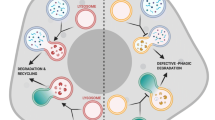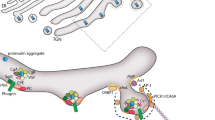Summary
Ultrastructural studies of pancreatic islets have suggested that crinophagy provides a possible mechanism for intracellular degradation of insulin in the insulin-producing B-cells. In the present study, a quantitative estimation of crinophagy in mouse pancreatic islets was attempted by morphometric analysis of lysosomes containing immunoreactive insulin. Isolated islets were incubated in tissue culture for one week in 3.3, 5.5 or 28 mmol/l glucose. The lysosomes of the pancreatic B-cells were identified by morphological and enzyme-cytochemical criteria and divided into three subpopulations comprising primary lysosomes and insulin-positive or insulin-negative secondary lysosomes. Both the volume and numerical density of the primary lysosomes increased with increasing glucose concentration. The proportion of insulin-containing secondary lysosomes was highest at 5.5 and lowest at 3.3 mmol/l glucose. Insulin-negative secondary lysosomes predominated at 3.3 mmol/l glucose. Studies of the dose-response relationships of glucose-stimulated insulin biosynthesis and insulin secretion of the pancreatic islets showed that biosynthesis had an apparent Km-value for glucose of 7.0 mmol/l, whereas it was 14.5 mmol/l for secretion. The pronounced crinophagic activity at 5.5 mmol/l glucose may thus be explained by the difference in glucose sensitivity between insulin biosynthesis and secretion resulting in an intracellular accumulation of insulin-containing secretory granules. The predominance of insulin-negative secondary lysosomes at 3.3 mmol/l glucose may reflect an increased autophagy, whereas the predominance of primary lysosomes at 28 mmol/l glucose may reflect a generally low activity of intracellular degradative processes.
Similar content being viewed by others
References
Andersson A (1978) Isolated mouse pancreatic islets in culture: Effects of serum and different culture media on the insulin production of the islets. Diabetologia 14:397–404
Andersson A, Hellerström C (1972) Metabolic characteristics of isolated pancreatic islets in tissue culture. Diabetes 21 [Suppl 2]: 546–554
Ashcroft SJH (1980) Glucoreceptor mechanisms and the control of insulin release and biosynthesis. Diabetologia 18:5–15
Borg LAH, Schnell AH (1986) Lysosomes and pancreatic islet function: Intracellular insulin degradation and lysosomal transformations. Diabetes Res Clin Exp 3:277–285
Duve C de (1969) The lysosome in retrospect. In: Dingle JT, Fell HB (eds) Lysosomes in biology and pathology, vol 1. North-Holland Publishing Co., Amsterdam London, pp 3–40
Goldman M (1968) Fluorescent antibody methods. Academic Press, New York London, pp 153–172
Halban PA, Renold AE (1983) Influence of glucose on insulin handling by rat islets in culture. A reflection of integrated changes in insulin biosynthesis, release, and intracellular degradation. Diabetes 32:254–261
Halban PA, Wollheim CB (1980) Intracellular degradation of insulin stores by rat pancreatic islets in vitro. An alternative pathway for homeostasis of pancreatic insulin content. J Biol Chem 255:6003–6006
Hanks JH, Wallace RE (1949) Relation of oxygen and temperature in the preservation of tissue by refrigeration. Proc Soc Exp Biol Med 71:196–200
Heding LG (1972) Determination of total serum insulin (IRI) in insulin-treated diabetic patients. Diabetologia 8:260–266
Holter H (1943) Technique of the Cartesian diver. CR Trav Lab Carlsberg Sér Chim 24:399–478
Keen H, Field JB, Pastan IH (1963) A simple method for in vitro metabolic studies using small volumes of tissue and medium. Metab Clin Exp 12:143–147
Krebs HA, Henseleit K (1932) Untersuchungen über die Harnstoffbildung im Tierkörper. Hoppe-Seyler's Z Physiol Chem 210:33–66
Luft JH (1961) Improvements in epoxy resin embedding methods. J Biophys Biochem Cytol 9:409–414
Morgan JF, Morton HJ, Parker RC (1950) Nutrition of animal cells in tissue culture. I. Initial studies on a synthetic medium. Proc Soc Exp Biol Med 73:1–8
Morgan JF, Campbell ME, Morton HJ (1955) The nutrition of animal tissues cultivated in vitro. I. A survey of natural materials as supplements to synthetic medium 199. J Natl Cancer Inst 16:557–567
Nielsen JH (1985) Growth and function of the pancreatic β cell in vitro. Effects of glucose, hormones and serum factors on mouse, rat and human pancreatic islets in organ culture. Acta Endocrinol (Copenh) 108 [Suppl 266]: 1–39
Orci L, Ravazzola M, Amherdt M, Yanaihara C, Yanaihara N, Halban P, Renold AE, Perrelet A (1984) Insulin, not C-peptide (proinsulin), is present in crinophagic bodies of the pancreatic B-cell. J Cell Biol 98:222–228
Poole MC, Mahesh VB, Costoff A (1981) Morphometric analysis of the autophagic and crinophagic lysosomal systems in mammotropes throughout the estrous cycle of the rat. Cell Tissue Res 220:131–137
Reynolds ES (1963) The use of lead citrate at high pH as an electron-opaque stain in electron microscopy. J Cell Biol 17:208–212
Schnell AH, Borg LAH (1985) Lysosomes and pancreatic islet function. Glucose-dependent alterations of lysosomal morphology. Cell Tissue Res 239:537–545
Schnell AH, Swenne I, Borg LAH (1984) Immunocytochemical demonstration of insulin in pancreatic islet lysosomes as evidence of a crinophagic mechanism for intracellular insulin degradation. Diabetologia 27:329
Varndell IM, Tapia FJ, Probert L, Buchan AMJ, Gu J, De Mey J, Bloom SR, Polak JM (1982) Immunogold staining procedure for the localisation of regulatory peptides. Peptides 3:259–272
Watson ML (1958) Staining of tissue sections for electron microscopy with heavy metals. J Biophys Biochem Cytol 4:475–478
Author information
Authors and Affiliations
Rights and permissions
About this article
Cite this article
Schnell, A.H., Swenne, I. & Borg, L.A.H. Lysosomes and pancreatic islet function. Cell Tissue Res. 252, 9–15 (1988). https://doi.org/10.1007/BF00213820
Accepted:
Issue Date:
DOI: https://doi.org/10.1007/BF00213820




